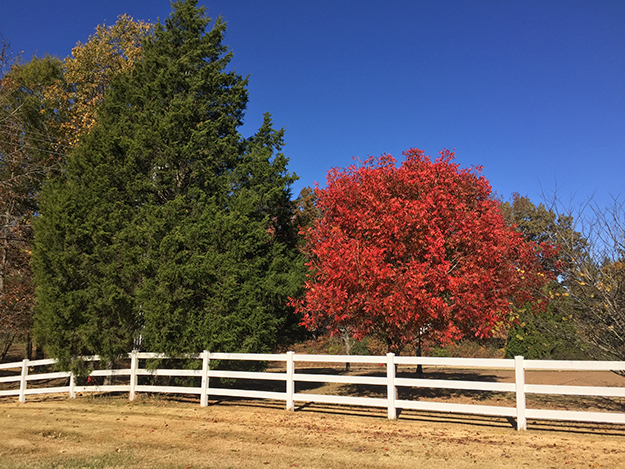| |
UT Gardens’ November 2017 Plant of the Month: Chinese pistache
By James Newburn, Assistant Director, UT Gardens, Knoxville
Last fall I was driving in my neighborhood and noticed a beautiful planting of street trees that was unfamiliar to me. What drew my attention was the symmetrical round shape, the delicate looking — almost lacy — foliage, and the brilliant red-orange fall color. I knew that this particular landscape had been designed by one of my University of Tennessee colleagues, Garry Menendez, whose office is right down the hall from mine, so it was to him that I turned for identification. He told me that the trees in question were Chinese pistache trees (Pistacia chinensis) and agreed that they were beautiful specimens.
I had to learn more.

This brilliant red Chinese pistache was photographed near Jackson, Tenn. The specimen's eye-catching fall color adds excitement to the landscape. Photo by J. Reeves, courtesy UTIA |
|
Related to the pistachio nut tree, P. chinensis has many qualities that make it a desirable choice for home or commercial landscapes. It is a smaller tree that typically grows to an average of 30 to 35 feet with an equal spread that makes it ideal for smaller urban or suburban yards. The compound leaves usually have between 10-12 leaflets, which give the tree a fine texture and creates a refreshing dappled shade effect. Chinese pistache is disease resistant and can tolerate heat, drought, a wide range of soil conditions and moderate air pollution. This is why you may see it, as I did, often planted as a street tree.
The most striking characteristic, however, is its fall color. As temperatures cool and days shorten, the foliage turns crimson red, brilliant orange or even yellow, often on the same tree. Leaf color can vary from tree to tree, but it is often very eye-catching. The smaller leaves make for easy fall-clean-up. Chinese pistache trees are either male or female and the ¼-inch seed produced on the female trees can be equally attractive growing in clusters that are red in color before ripening to a rich blue. Unlike its pistachio nut cousin though, Chinese pistache fruit is inedible, although birds seem to enjoy them. Hardy in zones 6-9, the tree may survive even a little further north with some winter wind and chill protection, for instance next to a fence or wall. Young trees in the nursery may appear gawky, but given time they will grow to a nice straight tree. Staking with a bamboo cane will help ensure a straight trunk, but this is not necessary.
Nice specimens can be seen at the University of Tennessee Gardens, Jackson, in the north shrub border, and on the UT Institute of Agriculture campus in Knoxville next to the Brehm Animal Science Building.
November is the time of year that we notice spectacular fall color and it is also a great time to plant trees. You may want to consider planting Chinese pistache now for years of enjoyment.
The UT Gardens includes plant collections located in Knoxville, Jackson and Crossville. Designated as the official botanical garden for the State of Tennessee, the collections are part of the UT Institute of Agriculture. The Gardens’ mission is to foster appreciation, education and stewardship of plants through garden displays, educational programs and research trials. The Gardens are open during all seasons and free to the public. For more information, see the Gardens website: ag.tennessee.edu/utg.
Published November 2, 2017 |

